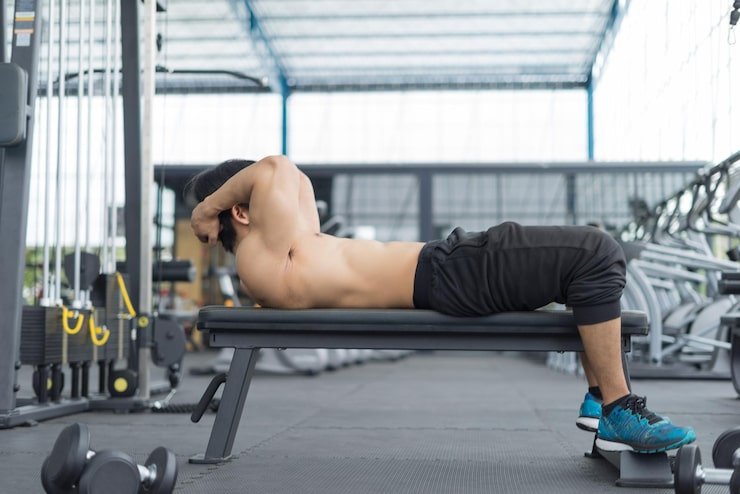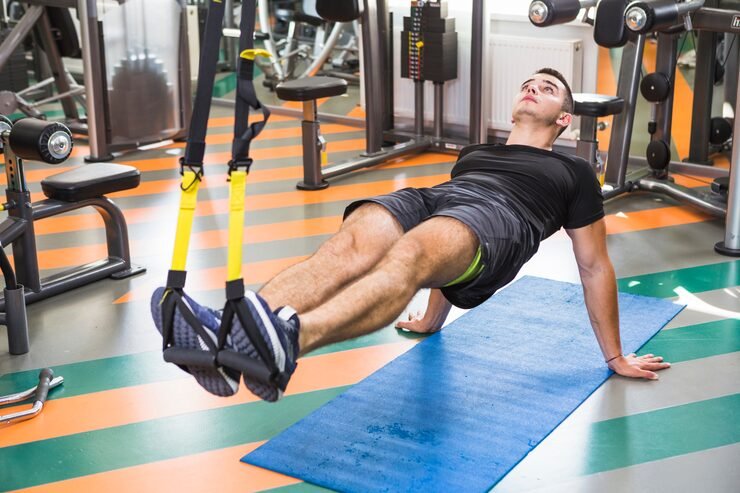Introduction
Dips are one of the most effective compound exercises for building upper-body strength. Often called the upper body squat, this powerful movement targets multiple muscle groups simultaneously.
Whether you’re using parallel bars at the gym or training at home, dips deliver exceptional results for arm and chest development. Understanding what muscles do dips workout helps you maximize your training and achieve your fitness goals faster.
Quick Answer: What Muscles Do Dips Workout?
Primary muscles worked:
- Triceps brachii (back of upper arm)
- Pectoralis major & minor (chest)
- Anterior deltoids (front shoulders)
Secondary muscles engaged:
- Latissimus dorsi (lats)
- Trapezius and rhomboids
- Core muscles (abs and obliques)
- Forearm muscles
The exact muscle emphasis depends on your body position upright for triceps, forward lean for chest.

Muscles Worked During Dips: Complete Breakdown
| Primary Muscles | Secondary Muscles |
| Triceps | Lats |
| Chest (Pecs) | Traps |
| Shoulders (Anterior Deltoids) | Rhomboids |
| Core | |
| Forearms |
Primary Muscles Worked in Dips
Triceps Brachii
The triceps are the main driver of the dip exercise, responsible for extending your elbows and pushing your body upward.
Key points about tricep activation:
- All three heads (long, lateral, medial) work together
- Makes up two-thirds of your upper arm mass
- More activation when elbows stay close to body
- Upright position maximizes tricep engagement
The elbow extension movement creates significant mechanical tension, making dips one of the best exercises for building arm size and strength.
Chest Muscles (Pectoralis Major & Minor)
Your chest muscles work heavily during dips, especially when you lean forward.
What do dips workout in the chest:
- Lower pectoralis major (often underdeveloped area)
- Upper and middle chest fibers
- Pectoralis minor for shoulder blade stability
- Maximum activation with 20-30 degree forward lean
Dips create a unique stretch in the lower chest that bench press can’t replicate, making them essential for complete chest development.
Anterior Deltoids (Front Shoulders)
Your front shoulders stabilize and assist throughout the dip movement.
Shoulder involvement:
- Control shoulder joint during the exercise
- Work hardest at the bottom position
- Build strength for other pressing movements
- More engagement during chest-focused dips
Strong anterior deltoids from dips improve overhead press and bench press performance.
Secondary Muscles Worked
Lats (Latissimus Dorsi)
Your lats provide stability during the lowering phase of dips.
They work isometrically to keep shoulders stable and prevent excessive forward rotation. Proper lat engagement protects your shoulder joint and creates a solid pressing foundation.
Upper Back (Traps & Rhomboids)
These muscles stabilize your shoulder blades during the dip exercise.
Functions:
- Keep scapulae in proper position
- Prevent shoulder blade winging
- Create stable platform for pressing
- Improve overall posture
Core Muscles
Your abs and obliques engage throughout dips to maintain body position.
The core prevents excessive swinging, arching, and rotation. This makes dips a functional movement that challenges your entire torso, not just upper body.
Forearms
Your forearm muscles maintain grip strength on the parallel bars.
While often overlooked, the isometric forearm contraction improves grip strength that carries over to pull-ups, rows, and deadlifts.
Chest Dips vs Tricep Dips: What’s the Difference?
| Factor | Tricep Dips | Chest Dips |
| Body Angle | Upright (vertical torso) | Forward lean (20-30°) |
| Elbow Position | Tucked close to body | Flared out at 45° |
| Grip Width | Shoulder-width or narrower | Slightly wider |
| Primary Focus | Triceps (60-70%) | Chest & shoulders |
| Best For | Arm size and strength | Chest development |
Form Differences
Tricep-Focused Dips:
- Keep torso as vertical as possible
- Elbows point backward, not outward
- Narrower grip position
- Maximum elbow extension emphasis
Chest-Focused Dips:
- Lean torso forward 20-30 degrees
- Allow elbows to flare outward
- Slightly wider grip if available
- Deeper stretch at bottom position
Muscle Activation Differences
What muscles do tricep dips work:
- Primary: Triceps (maximum activation)
- Secondary: Chest and shoulders (supporting role)
- Best for: Building bigger, stronger arms
What muscles do chest dips work:
- Primary: Chest and shoulders (heavy emphasis)
- Secondary: Triceps (still significantly involved)
- Best for: Lower chest development
Benefits of Doing Dips
Builds Massive Upper-Body Strength
Dips develop functional pressing power that transfers to sports and daily activities.
Adds Size to Arms and Chest
The combination of tension, muscle damage, and metabolic stress makes dips exceptional for hypertrophy.
Works Multiple Muscles Simultaneously
Stimulate your triceps, chest, shoulders, and core in one efficient exercise.
Easy Progressive Overload
Progress from assisted dips → bodyweight dips → weighted dips as you get stronger.
How to Perform Dips With Proper Form (Step-by-Step)
Step 1: Starting Position
- Grip parallel bars with palms facing inward
- Jump or step up to support position
- Arms fully extended, shoulders over hands
- Engage core and pull shoulder blades down
Step 2: The Descent (Lowering Phase)
- Take a deep breath
- Bend elbows and lower your body in a controlled manner
- Keep shoulders stable and engaged
- Continue until upper arms are parallel to ground
Step 3: Bottom Position
- Shoulders should be level with or slightly below elbows
- Maintain tension throughout your body
- Don’t relax or bounce at the bottom
- Brief pause for control
Step 4: The Ascent (Push Up)
- Drive through your palms forcefully
- Extend elbows to push yourself up
- Exhale as you press upward
- Return to starting position with arms extended
Step 5: Breathing Pattern
- Inhale during lowering phase
- Hold breath briefly at bottom
- Exhale forcefully while pressing up
Ideal Depth: Lower until shoulders are level with elbows (90-degree elbow bend).
Tempo: 2 seconds down, 1 second pause, 1-2 seconds up.
Common Mistakes and How They Affect Muscles
Flaring Elbows Too Wide (During Tricep Dips)
Problem: Reduces tricep activation and increases shoulder stress.
Fix: Keep elbows close to body for tricep-focused dips.
Not Going Deep Enough
Problem: Limits muscle activation and range of motion benefits.
Fix: Lower until upper arms are at least parallel to ground.
Incorrect Body Angle
Problem: Wrong lean defeats the purpose of your chosen variation.
Fix: Vertical for triceps, forward lean for chest.
Rushing Reps with Momentum
Problem: Reduces time under tension and increases injury risk.
Fix: Control the descent (2-3 seconds) and avoid bouncing.
Shoulders Shrugging Up
Problem: Places dangerous stress on shoulder joints.
Fix: Keep shoulders depressed (pulled down) throughout movement.

Best Dip Variations to Target Specific Muscles
1. Parallel Bar Dips
Best for: Overall upper body development
The gold standard variation offering perfect balance of safety and effectiveness. Adjust body angle to target chest or triceps.
2. Bench Dips
Best for: Beginners and tricep isolation
Hands on bench behind you, feet extended forward. Reduces load while emphasizing triceps. Great starting point for building strength.
3. Weighted Dips
Best for: Advanced strength and mass building
Add weight using dip belt, vest, or dumbbell between feet. Once you can do 10-15 bodyweight dips, weighted dips provide progressive overload.
4. Ring Dips
Best for: Stability and functional strength
The instability forces stabilizer muscles to work harder. Excellent for developing control but more challenging and risky for beginners.
5. Assisted Dips
Best for: Building strength toward full bodyweight dips
Use machine or resistance bands to reduce load. Gradually decrease assistance as strength improves.
Frequently Asked Questions
Do dips work chest or triceps more?
It depends on your form. Upright dips emphasize triceps (60-70% of the work), while forward-leaning dips shift focus to chest. Both variations work both muscle groups substantially, just with different emphasis.
Are dips better than push-ups?
Dips and push-ups work similar muscles but differently. Dips allow heavier loading (bodyweight plus added weight), creating more mechanical tension for muscle growth. Push-ups offer more variety and core engagement. Both exercises complement each other well.
Are dips safe for shoulders?
Dips are safe when performed with proper form and adequate mobility. However, they do stress the shoulder joint. If you have shoulder issues, start with assisted variations and stop if you feel sharp pain. Maintaining proper shoulder blade position protects your shoulders.
How many dips should beginners do?
Beginners should start with 3-5 quality reps if possible. Perform 2-3 sets, stopping 1-2 reps before failure. Focus on form over quantity. If you can’t do bodyweight dips yet, start with assisted dips or negative dips (lowering phase only).
Are dips safe for beginners?
Yes, when done properly. Beginners should start with assisted dips or bench dips to build strength. Focus on mastering form before progressing to full bodyweight dips. Always warm up shoulders thoroughly before dipping.
Can you do dips every day?
Not recommended. Dips are demanding on your joints and muscles. Allow 48-72 hours recovery between dip sessions. Most people benefit from dips 2-3 times per week maximum.
Conclusion
Dips are one of the most effective exercises for upper-body development, primarily targeting your triceps, chest, and shoulders while engaging your back, core, and forearms. This comprehensive muscle activation makes the dip exercise incredibly efficient for building strength and size.
Adjust your technique to emphasize different muscle groups upright for triceps, forward lean for chest. Progress from assisted variations through bodyweight dips and eventually to weighted dips for continued gains.
Incorporate dips into your training program with proper form and appropriate progression. Few exercises deliver such complete upper-body development in a single movement, which is why dips remain a staple for building impressive strength and muscle mass.



